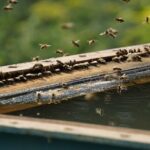Did you know that beneath our feet lies a hidden world of intricate societies, bustling with astonishing structures and complex communication systems? In this article, we will dive deep into the mesmerizing realm of termite societies, unraveling the secrets of these remarkable insects. From their diverse castes to their elaborate construction techniques, join me on a journey to unveil the intricacies of termite societies and discover the captivating wonders that lie within.

Intricate termite societies
Termites, fascinating creatures that they are, have long captivated the curiosity of scientists and nature enthusiasts alike. Their intricate societies, filled with complex social structures and remarkable behaviors, have become a subject of great interest. As we delve into the world of termites, we uncover a hidden realm of cooperation, division of labor, and construction prowess. Let’s embark on a journey to unravel the wonders of these intricate termite societies.
At the heart of termite societies lie castes, which determine the roles and responsibilities of each individual. Just like a well-orchestrated play, termites perform their designated tasks with utmost dedication. From the worker termites tirelessly tending to the colony’s needs, to the soldiers fiercely defending against threats, and the reproductive kings and queens ensuring the colony’s survival, each caste plays a vital role in the overall functioning of their society. The division of labor within termite colonies is unparalleled, making their social organization truly awe-inspiring.
But how do these tiny creatures communicate and coordinate their activities? Termites have evolved an intricate system of chemical signaling that allows them to transmit messages effectively. Through the release of pheromones, they can convey information about food sources, danger, and even the need for construction. By following these chemical trails, termites can communicate and collaborate with astonishing precision. The complexity of their communication system is a testament to the remarkable intelligence and social complexity found within termite societies.
One of the most remarkable aspects of termite societies is their ability to construct intricate structures. Unbeknownst to many, termites are master builders, creating elaborate mounds, tunnels, and galleries that serve as their homes. These constructions are not merely random piles of dirt, but rather carefully engineered marvels that provide optimal living conditions for the colony. By working together, termites can create ventilation systems, temperature regulation mechanisms, and even gardens for cultivating their own food sources. The sheer complexity and functionality of these structures make them a true testament to the ingenuity of these incredible insects.
Termites, often considered nature’s recyclers, have a profound impact on ecosystem function and maintaining biodiversity. By breaking down cellulose-rich materials such as wood, they aid in nutrient cycling and promote soil fertility. This vital ecological role of termites cannot be overstated, as they contribute to the overall health of ecosystems and support the diversity of life that thrives within them.
In conclusion, the intricate termite societies that exist within their mounds are a marvel of nature. Their well-organized castes, intricate communication systems, and elaborate construction techniques showcase the brilliance of these tiny creatures. Exploring the complexities of termite societies not only reveals the wonders of the insect world, but also reminds us of the remarkable diversity of life on our planet. So next time you come across a termite mound, take a moment to appreciate the hidden world within and the remarkable intricacies that make it thrive.
“Termites, the architects of their own universe, demonstrate how the collaboration of even the smallest individuals can bring forth astonishing results.”
Termites can cause serious damage to your home, but don’t let that scare you! Knowledge is power, and our Termite Fact Sheet has all the information you need to protect your property. From identifying signs of termites to prevention and treatment options, this comprehensive resource covers it all. Click here to access the Termite Fact Sheet and arm yourself with the knowledge to keep your home termite-free: Termite Fact Sheet. Remember, prevention is key when it comes to termites, so don’t wait until it’s too late!

FAQ
Question 1
What are termite societies and why are they considered complex and intricate systems of social organization?
Answer 1
Termite societies refer to the organized colonies in which termites live and work together. These societies are considered complex and intricate due to the division of labor among different castes, the communication systems termites use, and the elaborate construction techniques they employ.
Question 2
How do termites differ from other social insects like bees, ants, and wasps?
Answer 2
Termites evolved from ancestral solitary cockroaches at least 50 million years before bees, ants, and wasps. They have their own unique social structures and behaviors that distinguish them from other social insects.
Question 3
What are the castes within a termite society?
Answer 3
At the heart of termite societies are different castes, which are specialized groups of individuals with specific roles and functions. The castes in a termite society typically include the reproductive caste, the soldier caste, and the worker caste.
Question 4
How do termites contribute to ecosystem function and biodiversity?
Answer 4
Termites play a crucial role in maintaining ecosystem function and biodiversity. They help decompose wood and recycle nutrients, which contributes to nutrient cycling in ecosystems. Additionally, termite mounds provide habitat for a wide range of organisms, further enhancing biodiversity.
Question 5
What is the significance of termites’ ability to digest wood?
Answer 5
Termites have the ability to digest wood with the aid of a diverse symbiotic gut fauna. This unique ability allows them to break down and utilize cellulose, which is the main component of wood. Termites’ wood-digesting abilities have important ecological implications, as they contribute to the decay of dead wood and the recycling of nutrients in ecosystems.











